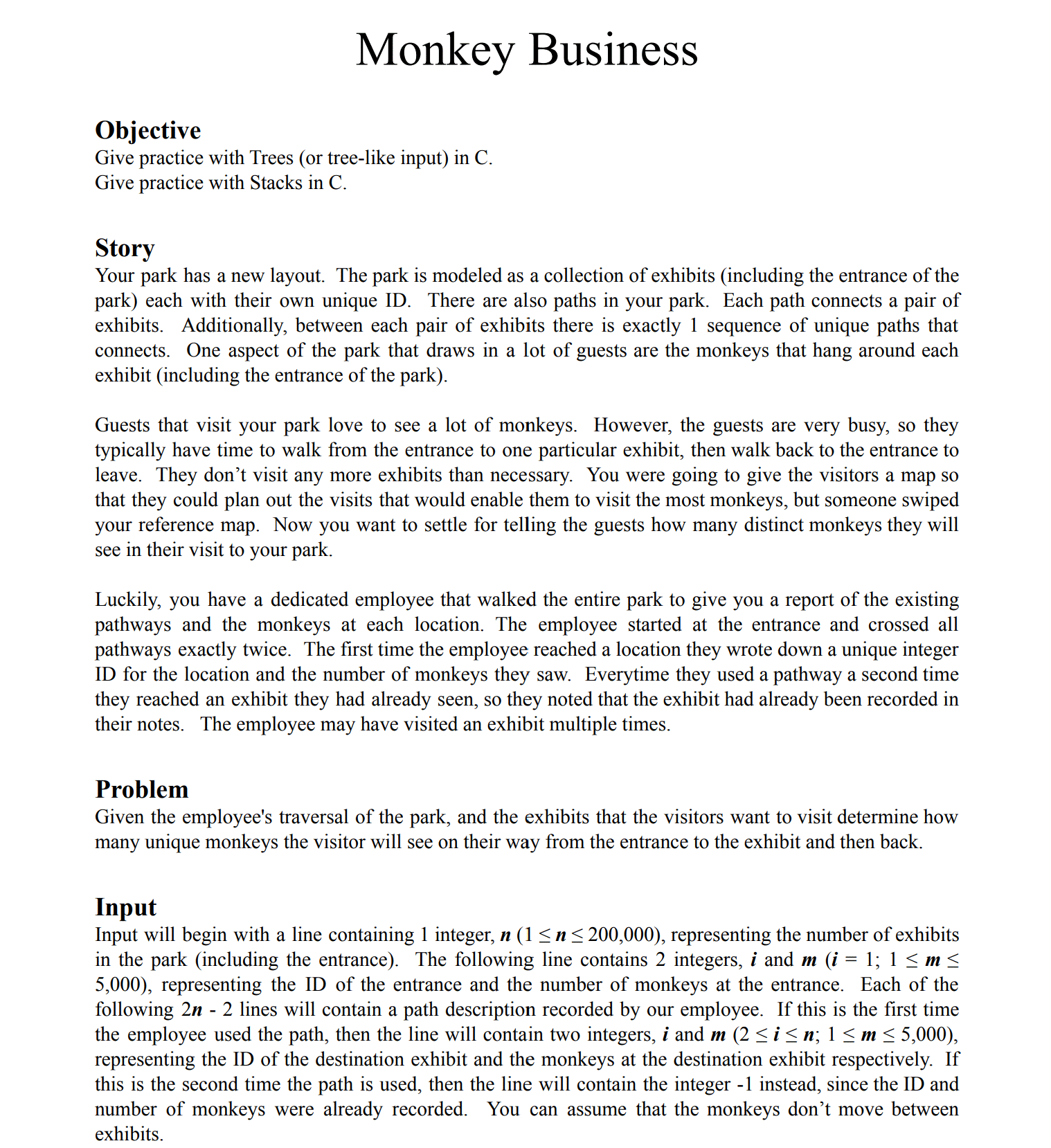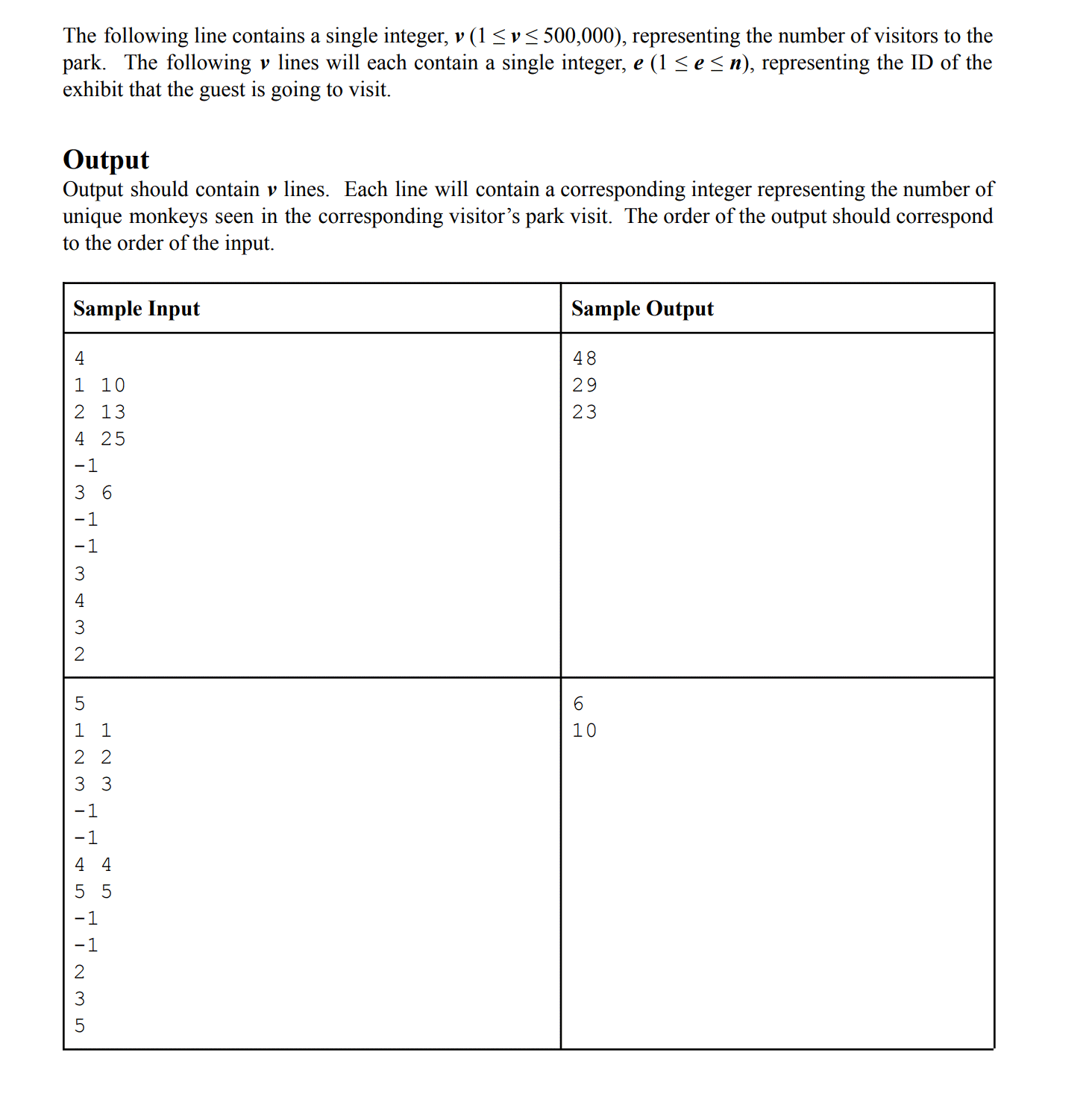Problem Given the employee's traversal of the park, and the exhibits that the visitors want to visit determine how many unique monkeys the visitor will see on their way from the entrance to the exhibit and then back. Input Input will begin with a line containing 1 integer, n (1 ≤ n ≤ 200,000), representing the number of exhibits in the park (including the entrance). The following line contains 2 integers, i and m (i = 1; 1 ≤ m ≤ 5,000), representing the ID of the entrance and the number of monkeys at the entrance. Each of the following 2n - 2 lines will contain a path description recorded by our employee. If this is the first time the employee used the path, then the line will contain two integers, i and m (2 ≤ i ≤n; 1 ≤m≤ 5,000), representing the ID of the destination exhibit and the monkeys at the destination exhibit respectively. If this is the second time the path is used, then the line will contain the integer -1 instead, since the ID and number of monkeys were already recorded. You can assume that the monkeys don't move between exhibits.
Problem Given the employee's traversal of the park, and the exhibits that the visitors want to visit determine how many unique monkeys the visitor will see on their way from the entrance to the exhibit and then back. Input Input will begin with a line containing 1 integer, n (1 ≤ n ≤ 200,000), representing the number of exhibits in the park (including the entrance). The following line contains 2 integers, i and m (i = 1; 1 ≤ m ≤ 5,000), representing the ID of the entrance and the number of monkeys at the entrance. Each of the following 2n - 2 lines will contain a path description recorded by our employee. If this is the first time the employee used the path, then the line will contain two integers, i and m (2 ≤ i ≤n; 1 ≤m≤ 5,000), representing the ID of the destination exhibit and the monkeys at the destination exhibit respectively. If this is the second time the path is used, then the line will contain the integer -1 instead, since the ID and number of monkeys were already recorded. You can assume that the monkeys don't move between exhibits.
Computer Networking: A Top-Down Approach (7th Edition)
7th Edition
ISBN:9780133594140
Author:James Kurose, Keith Ross
Publisher:James Kurose, Keith Ross
Chapter1: Computer Networks And The Internet
Section: Chapter Questions
Problem R1RQ: What is the difference between a host and an end system? List several different types of end...
Related questions
Question
C-Language. Stacks or Trees.
I am having issues with this

Transcribed Image Text:Monkey Business
Objective
Give practice with Trees (or tree-like input) in C.
Give practice with Stacks in C.
Story
Your park has a new layout. The park is modeled as a collection of exhibits (including the entrance of the
park) each with their own unique ID. There are also paths in your park. Each path connects a pair of
exhibits. Additionally, between each pair of exhibits there is exactly 1 sequence of unique paths that
connects. One aspect of the park that draws in a lot of guests are the monkeys that hang around each
exhibit (including the entrance of the park).
Guests that visit your park love to see a lot of monkeys. However, the guests are very busy, so they
typically have time to walk from the entrance to one particular exhibit, then walk back to the entrance to
leave. They don't visit any more exhibits than necessary. You were going to give the visitors a map so
that they could plan out the visits that would enable them to visit the most monkeys, but someone swiped
your reference map. Now you want to settle for telling the guests how many distinct monkeys they will
see in their visit to your park.
Luckily, you have a dedicated employee that walked the entire park to give you a report of the existing
pathways and the monkeys at each location. The employee started at the entrance and crossed all
pathways exactly twice. The first time the employee reached a location they wrote down a unique integer
ID for the location and the number of monkeys they saw. Everytime they used a pathway a second time
they reached an exhibit they had already seen, so they noted that the exhibit had already been recorded in
their notes. The employee may have visited an exhibit multiple times.
Problem
Given the employee's traversal of the park, and the exhibits that the visitors want to visit determine how
many unique monkeys the visitor will see on their way from the entrance to the exhibit and then back.
Input
Input will begin with a line containing 1 integer, n (1 ≤n≤200,000), representing the number of exhibits
in the park (including the entrance). The following line contains 2 integers, i and m (i = 1; 1 ≤ m<
5,000), representing the ID of the entrance and the number of monkeys at the entrance. Each of the
following 2n - 2 lines will contain a path description recorded by our employee. If this is the first time
the employee used the path, then the line will contain two integers, i and m (2 ≤ i ≤ n; 1 ≤ m ≤ 5,000),
representing the ID of the destination exhibit and the monkeys at the destination exhibit respectively. If
this is the second time the path is used, then the line will contain the integer -1 instead, since the ID and
number of monkeys were already recorded. You can assume that the monkeys don't move between
exhibits.

Transcribed Image Text:The following line contains a single integer, v (1 ≤ v≤ 500,000), representing the number of visitors to the
park. The following lines will each contain a single integer, e (1 ≤ e ≤ n), representing the ID of the
exhibit that the guest is going to visit.
Output
Output should contain v lines. Each line will contain a corresponding integer representing the number of
unique monkeys seen in the corresponding visitor's park visit. The order of the output should correspond
to the order of the input.
Sample Input
4
1 10
2 13
4 25
-1
3 6
-1
-1
MI IMAM N
3
4
3
2
5
1 1
22
3 3
-1
77
-1
4 4
5 5
UT W NA
-1
-1
2
3
5
Sample Output
48
∞003
29
N N
23
6
10
Expert Solution
This question has been solved!
Explore an expertly crafted, step-by-step solution for a thorough understanding of key concepts.
This is a popular solution!
Trending now
This is a popular solution!
Step by step
Solved in 3 steps with 2 images

Follow-up Questions
Read through expert solutions to related follow-up questions below.
Follow-up Question
Thank you. I see that this works, but I am trying to work with the stack operators. Can you show me how you would implement 'pop' and 'push' in this scenario?
Solution
Recommended textbooks for you

Computer Networking: A Top-Down Approach (7th Edi…
Computer Engineering
ISBN:
9780133594140
Author:
James Kurose, Keith Ross
Publisher:
PEARSON

Computer Organization and Design MIPS Edition, Fi…
Computer Engineering
ISBN:
9780124077263
Author:
David A. Patterson, John L. Hennessy
Publisher:
Elsevier Science

Network+ Guide to Networks (MindTap Course List)
Computer Engineering
ISBN:
9781337569330
Author:
Jill West, Tamara Dean, Jean Andrews
Publisher:
Cengage Learning

Computer Networking: A Top-Down Approach (7th Edi…
Computer Engineering
ISBN:
9780133594140
Author:
James Kurose, Keith Ross
Publisher:
PEARSON

Computer Organization and Design MIPS Edition, Fi…
Computer Engineering
ISBN:
9780124077263
Author:
David A. Patterson, John L. Hennessy
Publisher:
Elsevier Science

Network+ Guide to Networks (MindTap Course List)
Computer Engineering
ISBN:
9781337569330
Author:
Jill West, Tamara Dean, Jean Andrews
Publisher:
Cengage Learning

Concepts of Database Management
Computer Engineering
ISBN:
9781337093422
Author:
Joy L. Starks, Philip J. Pratt, Mary Z. Last
Publisher:
Cengage Learning

Prelude to Programming
Computer Engineering
ISBN:
9780133750423
Author:
VENIT, Stewart
Publisher:
Pearson Education

Sc Business Data Communications and Networking, T…
Computer Engineering
ISBN:
9781119368830
Author:
FITZGERALD
Publisher:
WILEY